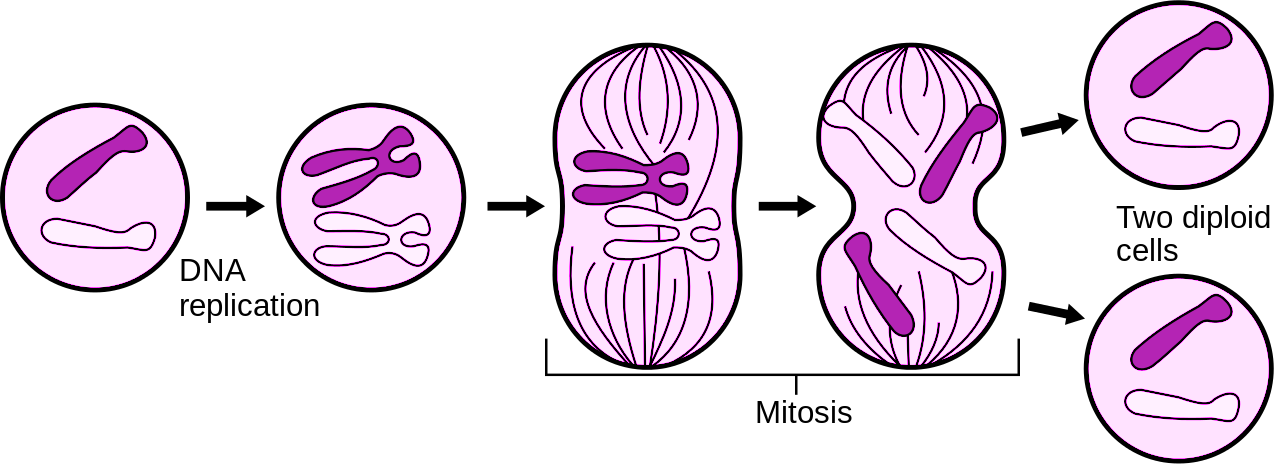
When a cell reproduces, what happens to its DNA? Is it copied and incorporated into offspring?
Answer
420.4k+ views
Hint: Cell divides to form new cells and these newly formed cells are the daughter cells or offspring of the parent cell. This division is completed in two major stages - karyokinesis and cytokinesis.
Complete answer:
In the process of cell reproduction, the cells divide to form new cells and each time a cell divides, it forms a copy of all of its chromosomes and evenly distributes to all the newly formed cells. The chromosomes are tightly coiled strands of DNA that contain all the instructions and information for all the life. This can be either by mitosis or meiosis but in both the processes, the complete copy of DNA or a part of parent DNA is transferred to the offspring.
A diagram representing mitosis has been shown below –

It can be seen in the diagram of how the replicated DNA is distributed between the daughter cells.
Additional information :
The steps that cells take to grow, develop, and reproduce are collectively called a cell cycle and it consists of five stages which have been written below –
1. G1 Phase
2. S Phase
3. G2 Phase
4. M Phase
5. Cytokinesis
Note: It is the S Phase during which DNA replication takes place and the genetic material is prepared to be divided into daughter cells. The actual division takes place in M Phase which is a division of the nucleus of the cell and hence termed as karyokinesis.
This is followed by cytokinesis in which the cytoplasm divides and daughter cells are formed with an equal amount of DNA content.
Complete answer:
In the process of cell reproduction, the cells divide to form new cells and each time a cell divides, it forms a copy of all of its chromosomes and evenly distributes to all the newly formed cells. The chromosomes are tightly coiled strands of DNA that contain all the instructions and information for all the life. This can be either by mitosis or meiosis but in both the processes, the complete copy of DNA or a part of parent DNA is transferred to the offspring.
A diagram representing mitosis has been shown below –

It can be seen in the diagram of how the replicated DNA is distributed between the daughter cells.
Additional information :
The steps that cells take to grow, develop, and reproduce are collectively called a cell cycle and it consists of five stages which have been written below –
1. G1 Phase
2. S Phase
3. G2 Phase
4. M Phase
5. Cytokinesis
Note: It is the S Phase during which DNA replication takes place and the genetic material is prepared to be divided into daughter cells. The actual division takes place in M Phase which is a division of the nucleus of the cell and hence termed as karyokinesis.
This is followed by cytokinesis in which the cytoplasm divides and daughter cells are formed with an equal amount of DNA content.
Recently Updated Pages
Master Class 12 Economics: Engaging Questions & Answers for Success

Master Class 12 Maths: Engaging Questions & Answers for Success

Master Class 12 Biology: Engaging Questions & Answers for Success

Master Class 12 Physics: Engaging Questions & Answers for Success

Master Class 12 Business Studies: Engaging Questions & Answers for Success

Master Class 12 English: Engaging Questions & Answers for Success

Trending doubts
Who is Mukesh What is his dream Why does it look like class 12 english CBSE

Who was RajKumar Shukla Why did he come to Lucknow class 12 english CBSE

The word Maasai is derived from the word Maa Maasai class 12 social science CBSE

What is the Full Form of PVC, PET, HDPE, LDPE, PP and PS ?

Why is the cell called the structural and functional class 12 biology CBSE

Which country did Danny Casey play for class 12 english CBSE




